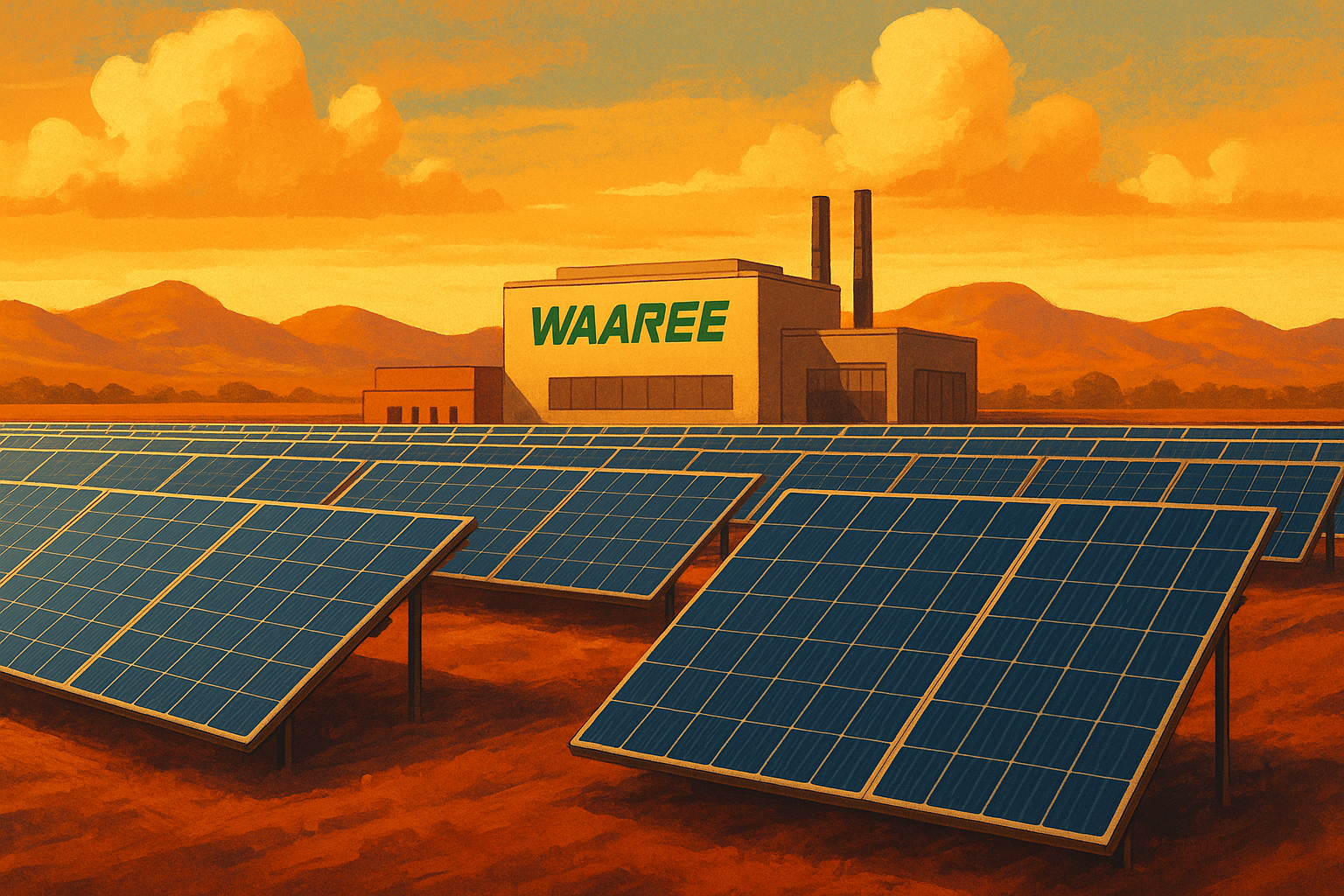Waaree Energies Ltd has made a decisive move to expand its presence in the US solar market by acquiring a solar module assembly unit in a distressed sale. The deal, while strategic in shoring up manufacturing capacity and diversifying its technology base, comes at a time when the company faces twin pressures: patent disputes and a US investigation into potential anti-dumping duty evasion.
The Acquisition: A Bargain Deal for Advanced Capacity
Through its subsidiary Waaree Solar Americas Inc., Waaree Energies secured approval to purchase a portion of the bankrupt Swiss firm Meyer Burger’s US assets for $18.5 million (₹164 crore). The acquisition includes an advanced assembly line capable of producing 1 GW of solar modules annually using heterojunction technology (HJT), widely considered the most efficient solar panel technology available today.
The purchase price stands in stark contrast to Waaree’s earlier investment of $80–85 million in building a 1.6 GW Texas facility. Analysts view this fire-sale acquisition as a cost-effective hedge, giving Waaree a technological edge while diversifying beyond its existing tunnel oxide passivated contact (TOPCon) solar panels.
Rising Stakes in the US Market
Waaree’s bet on the US is significant. More than half of its ₹49,000 crore order book as of June 30 comes from this market. The company is already working to double its Texas capacity from 1.6 GW to 3.2 GW by year-end. However, this expansion coincides with legal and regulatory scrutiny that could complicate its growth ambitions.
- Patent Dispute: First Solar, a leading US solar cell manufacturer, has alleged that Waaree’s TOPCon cells infringe two of its patents. The company has demanded Waaree either cease production or license the technology, with legal action looming if compliance is not met.
- Trade Investigation: US Customs and Border Protection has launched a formal investigation into whether Waaree evaded anti-dumping and countervailing duties by misdeclaring Chinese and Southeast Asian cells as India-made. Waaree has acknowledged the probe, pledging to cooperate fully.
These challenges triggered a sharp 7% intraday drop in Waaree’s stock last Friday, underscoring investor concerns about the company’s exposure to US risks.
Technology Hedge: Betting on HJT
Waaree’s new capacity marks its entry into HJT, a more advanced technology than TOPCon. While HJT panels are costlier, they deliver higher efficiency, appealing to premium customers. Reliance Industries remains the only major Indian player committed to HJT, giving Waaree an opportunity to differentiate itself in the US.
By adding HJT to its portfolio, Waaree not only broadens its customer base but also creates a buffer against the First Solar patent dispute tied to its TOPCon technology. The company will also inherit Meyer Burger’s existing client relationships and is seeking stable supplies of HJT cells to fuel production at the new plant.
Beyond Assembly: Building the Value Chain
Currently, Waaree’s US operations focus on module assembly—the final step in the solar value chain. But the company has more ambitious plans. It is investing upstream in wafers and ingots, targeting 10 GW of wafer and ingot capacity by FY28. This vertical integration could enhance its competitiveness, reduce supply chain risks, and insulate it from oversupply shocks in the module market.
At home, Waaree is already India’s largest solar module manufacturer, with 16.7 GW of module and 5.4 GW of cell manufacturing capacity. It aims to scale these to 25.7 GW and 15.4 GW, respectively, by FY27. Analysts at Anand Rathi note that Waaree’s scale and backward integration give it relative resilience in a market facing cyclical oversupply.
The Road Ahead
Waaree’s acquisition of Meyer Burger’s US assets reflects both opportunity and urgency. The deal strengthens its foothold in the world’s most lucrative solar market and adds technological diversity through HJT. Yet, the company’s future hinges on how it navigates ongoing trade and legal headwinds.
If Waaree can successfully defend itself against patent and duty evasion claims while executing its expansion plans, the Meyer Burger acquisition could prove transformative. But if regulatory and legal risks materialize, this bold bet could become a costly gamble at a critical juncture for India’s solar export leader.
Feel free to share your experiences and insights in the comments below. Let’s continue the conversation and grow together as a community of traders and analysts.
By sharing this experience and insights, I hope to contribute to the collective knowledge of our professional community, encouraging a culture of strategic thinking and informed decision-making.
As always, thorough research and risk management are crucial. The dynamic nature of financial markets demands vigilance, agility, and a deep understanding of the tools at your disposal. Here’s to profitable trading and navigating the election season with confidence!
Ready to stay ahead of market trends and make informed investment decisions? Follow our page for more insights and updates on the latest in the financial world!
For a free online stock market training by Yogeshwar Vashishtha (M.Tech IIT) this Saturday from 11 am – 1 pm, please sign up with https://pathfinderstrainings.in/training/freetrainings.aspx
Experience profits with my winning algo strategies – get a free one-month trial with ₹15 lakh capital! – https://terminal.algofinders.com/algo-terminal
Disclaimer
This article should not be interpreted as investment advice. For any investment decisions, consult a reputable financial advisor. The author and publisher are not responsible for any losses incurred by investors or traders based on the information provided.


